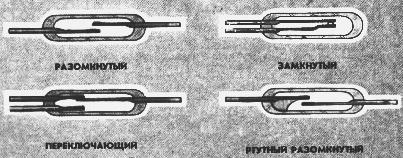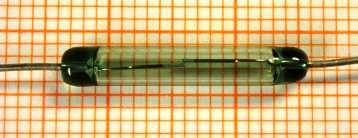Categories: Interesting Facts, Novice electricians, How does it work
Number of views: 151321
Comments on the article: 2
What are reed switches, how they are arranged and work
 A brief history of the creation of reed switches
A brief history of the creation of reed switches
Switching devices or just contacts are very widely used in various electrical and radio equipment. In order to improve operational properties, especially the service life and reliability of the connection, they were developed magnetically controlled sealed contacts called reed switches.
The first samples of such contacts appeared in the 30s of the last century, and the first magnetically controlled contact was invented in 1922 in St. Petersburg by Professor V. Kovalenkov, for which he was issued the USSR copyright certificate No. 466. The design of such a contact is shown in Figure 1.
Arranged such contact as follows. To the core 3 of soft magnetic material through the insulating gaskets 5 are attached contacts 1 and 2, also made of soft magnetic material. When passing current through the coil 4 in the core 3, a magnetic field appears and magnetizes the contacts 1 and 2, which are closed. The opening of the contacts occurs when the current through the coil ceases.
Figure 1. Magnetically controlled contact of Professor V. Kovalenkov
In fact, this was the very first magnetically controlled contact, only without a sealing shell. A similar contact was first placed in the sealing shell by an American engineer W.B. Ellwood only in 1936. In the seventies of the last century, reed switches reached their maximum development, and are widely used in various electronic devices.
Currently, reed switches are used less intensively, because they are "crowded out" Hall sensors. But in some cases, the reed switches remained out of competition, due to the ease of use, galvanic isolation from the power source, the properties of the "dry contact", so the reed switches are still used in various circuits and devices.
In cases where high reliability and durability of the switching element is required reed switches simply irreplaceable. As part of the reed switch are included in the design of various sensors, electromagnetic relays, especially low-current, as well as position switches and some other devices.
Varieties of Reed Switches
As well as regular contacts, reed switches can be closing (1 normally open contact), switching (1 switching contact) and opening (1 normally closed contact). This division is based on functional characteristics.
According to the signs of structural - technological reed switches are divided into two large groups: with dry contacts and with mercury contacts. The first variety is called dry reed switches, and the second is mercury reed switches. Actually, there is nothing special in the work of dry reed switches, in comparison with ordinary contacts.
In mercury reed switches inside a sealed glass case, in addition to contacts, there is also a drop of mercury. The purpose of this mercury droplet is to wet the contacts during operation to improve the quality of the contact by reducing the transition resistance, and also to get rid of the bounce of the contacts.
Chatter is called contact vibration during closing and opening, which, when activated once, leads to repeated switching of the transmitted signal, and in addition to a significant increase in response time.
Imagine that such a bounce will be present in audio amplifier while switching the input signal! In the case when such a rattling contact works in conjunction with digital microcircuits, measures have to be taken to suppress chatter in the form of RC chains or RS - triggers.
Various contacts, including reed contacts, are also used in modern microcontroller circuits, but in them contact bounce is suppressed programmatically. It also reduces the overall performance of the system.
Reed Switch Design
The design of various types of reed switches is shown in Figure 2.
Picture 2. Reed Switch Design
All reed switches are sealed glass bottleinside which is located contact Group. Contacts are magnetic cores welded into the ends of the cylinder. The outer ends of the cores are designed to be connected to an external electrical circuit.
The most widespread reed switch with contact group or as shown in the figure “open”. Each contact - core is made of ferromagnetic elastic wire, which is flattened to a rectangular shape. Permalloy wire with a diameter of 0.5 - 1.3 mm is used for the manufacture of cores, depending on the power of the reed switch and, accordingly, its dimensions.
Directly contacting surfaces are coated with noble metal, gold, palladium, rhodium, silver and alloys based on them. Such a coating not only reduces transition resistance, but also contributes to increased corrosion resistance of the contact surface.
The internal space of the container is filled with an inert gas (hydrogen, argon, nitrogen or a mixture thereof) or simply evacuated, also helps to reduce contact corrosion and increase their reliability. In the manufacture of cores are positioned so that between them there is a gap, by the way, of a certain size.
Fig. 3. Reed switch
The principle of the reed switch
In order to trigger the contact group, it is necessary to create a magnetic field of sufficient strength around the reed switch. Moreover, it does not matter how this field is created, either simply by a permanent magnet or by an electromagnet. The lines of force of the external magnetic field magnetize the internal contacts - the cores of the reed switch, as a result of which they overcome the elastic forces, attract and close the electric circuit.
In this state, the contacts will remain as long as there is a magnetic field of sufficient strength around them: it is enough to turn off the electromagnet or remove the usual permanent magnet away, as soon as the contacts open. The next contact operation will occur when the magnetic field reappears. From the foregoing, we can conclude that the contacts perform three functions at once: elastic elements (springs), the magnetic circuit, and the conductive contacts themselves.
The reed switch, working on opening, is somewhat different. Its magnetic system is designed so that when exposed to a magnetic field, the contacts - cores are magnetized by the same name, therefore they repel each other, breaking the electrical circuit.
A switching reed switch has one of three contacts, as a rule, normally - closed is made of non-magnetic metal, and both normally - open contacts are made of ferromagnetic, as mentioned above. Therefore, when a magnetic field acts on a reed switch, normally open contacts simply close, and a non-magnetic normally closed contact, remaining in its original place, opens.
Note. Normally open contact, which is open in the absence of a control action, in this case a magnetic field. Respectively normally closed contact closed in the absence of a magnetic field.
Of course, a magnetic field is always present, for example, the magnetic field of the Earth. And it seems impossible to say about the absence of a magnetic field at all. But the Earth’s magnetic field is not enough for the reed switch to operate, therefore it can be neglected and the absence of a magnetic field, in this case external, can be said.
Read on in the next article.
Continuation of the article: "Reed switches: control methods, examples of use"
Boris Aladyshkin
See also at bgv.electricianexp.com
:



